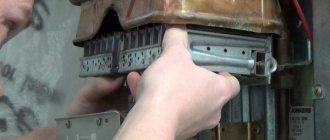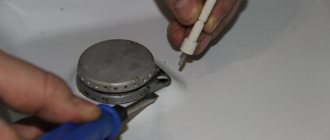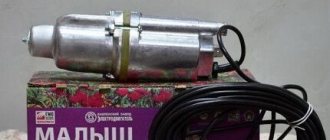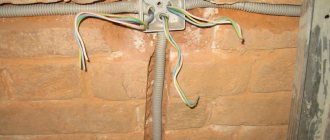Immediately after constructing a well or borehole, the question arises: how will we pump water? The cheapest, most unpretentious and widely available option is a vibration pump for a well. That is why so many summer residents choose it. Ask your neighbors how their water supply is arranged, you will probably hear: “And my Baby is in the well, and I have a Brook,” and another may tell you, “Don’t listen to them all, you need to install a centrifugal pump for the well.” How to make the right choice, what to focus on and what parameters to take into account, let's try to figure it out.
Pump device Baby
In the event of a breakdown, it is impossible to carry out high-quality repairs if the owner does not know what the principle of operation of the device is and what elements it consists of.
Information can be studied in the instructions if it is not lost.
Let's look at the design of the vibration pump Malysh.
- The main and largest element is the metal body. It must be as reliable as possible so that the pump can be immersed in deep water.
- Electromagnet.
- Vibration wire.
- Valve.
- Piston.
- Shock absorbers.
Device diagram Source belamos-expert.ru
The design of the Malysh pump can have several different variations. For example, water intake can be bottom or top.
With top fence
The specificity of the device is that the valve responsible for water suction will be located at the very top of the housing. At the same time, the manufacturer placed the electric drive in the lower part.
This pump has several clear advantages.
- The electrics of the pump are under the water column during operation. This means that it will not get very hot.
- Sediments in the form of silt and debris are too heavy. They will not rise to the top where the suction pipe is located.
With lower fence
The design of the Baby pump with a lower water intake has exactly the same design. However, the elements and mechanisms are located exactly the opposite. The electric drive is located on the top of the housing, and the suction valve is located on the bottom.
For a model with a lower intake, the valve is located at the bottom Source ai911.ru
In this case, the owners of the Baby must constantly monitor the normal water level. If the pump operates “dry”, that is, it is not completely immersed in water, overheating is possible.
Conclusion
Vibration-type submersible pumps are popular and simple products that do not require frequent maintenance. The main failure of the device, which excludes further repairs, is the deformation of the metal rod, which is connected to the armature.
Vibrating ones do not consume a large amount of electricity, provide sufficient volumes of water, and have a long service life. The absence of complex power units and moving parts ensures quick repairs with minimal financial costs. According to a large number of positive reviews, vibration pumps are in demand and popular.
Varieties
The manufacturer offers several versions of the “Malysh” pump of different modifications.
- "Baby". This pump is equipped with a bottom liquid intake function. One of the most powerful modifications, suitable for working in thick water. But at the bottom it doesn’t show itself in the best way. Often collects silt and dirt, clogging the interior space.
- "Baby-M" The model is equipped with top fence functions. The power is not as high as the previous version. But on the other hand, it has the function of sifting out dirt and silt from the bottom. Owners of this model often experience overheating, since as a result of a drop in water level, the pump is exposed to air and overheats.
- "Baby-K." Equipped with a bottom fence function. Grounded. It is equipped with a powerful motor, which affects the cost. Not equipped with a dirt filter.
- "Baby 3". The model is suitable for narrow wells and boreholes. Has compact dimensions. Power is low.
Types of pumps Baby Source santprice.ru
What types of malfunctions are there?
Very often, owners encounter various problems with the operation of pumps. Depending on the specifics, how to repair the Baby pump depends on the nature of the breakdown - it relates to a technical or mechanical part.
Some users themselves provoke a partial malfunction (for example, the filtration system is broken, but the pump is still pumping water). Or the device is rendered completely inoperative. Let's look at the main types of problems.
Electrical breakdowns
The main electrical problem with the Malysh submersible pump is related to the failure of the coil. The result is a breakdown to the housing or complete burnout. The latter is possible when the pump runs dry after the water level has dropped.
Coil location in the Malysh pump circuit Source themechanic.ru
Due to the lack of water, the insulation begins to burn, the materials expand, the yoke falls out of the housing, and the coil fails. Depending on how early it is possible to see that the pump is running idle, this can either partially affect the performance of the device or completely disable it.
In order to avoid such problems, you must carefully follow the operating rules and do not leave the pump running without water.
See also: Catalog of companies that specialize in electrical work of any complexity
Mechanical breakdowns
There are many more reasons for failure and each requires detailed consideration.
Parts are calcified
This happens when the pump operates in hard water. First, a small white coating appears on the “insides,” like scale. Owners of the Malysh pump must clean it in a timely manner. But if you neglect this procedure, then very soon it will affect your work.
The presence of limestone may jam the device. Most often this happens in the cold season, when frost sets in.
Limescale is the main enemy of the Malysh pump Source moikolodets.ru
The integrity of the pump is compromised
This happens when the body is deformed. Most often, the fins of the pump are hit. When examining a deformed device, it seems that someone specially used a saw or a router. But that's not true. The fact is that the pump is in contact with the concrete surface of the well. Due to strong friction, the integrity of the body is compromised.
The cavity is clogged
This most often happens with submersible pumps. Sometimes the device lies on the bottom, where there is an abundance of silt, sand, stones, earth, algae and other debris. The device begins to suck them in. Debris sticks to the valve and disrupts the seal.
Pump Baby, stained with sludge Source lovedacha.ru
As a result, the device can no longer develop good power and work at full capacity.
The thread is loose
This occurs due to excessive strong vibration or friction of the housing against the walls of the well. Usually the nuts that hold the piston in place are affected. Unfortunately, if this problem is not completely eliminated, it can lead to complete destruction of the case, when repair will not help.
Thinning rubber
Rubber gaskets are used to ensure a tight fit of the parts inside the Malysh pump body. Over time, the rubber wears out and wears out, causing the power of the device to rapidly decrease.
Gaskets from the Malysh pump repair kit Source youla.io
Sometimes it even stops working completely.
Purpose of the deep vibrator
Submersible pumps of the “Malysh” series are produced by the Russian company Livgidromash, whose history goes back almost seventy years. During this time, more than three million units of various pumping equipment rolled off the plant's assembly line.
Despite the wide selection of submersible units that the market offers today, many consumers choose the products of the Livensky plant. And it is no coincidence that “Malysh” pumps, thanks to their good technical characteristics, ease of use and low cost, withstand the competition with dignity.
The Malysh pump is an affordable and easy-to-maintain unit that allows you to provide water to summer cottages that do not have a centralized water supply.
The device, small in size (up to 255 mm) and weight (up to 3.4 kg), will cope with a number of tasks with a bang.
It will provide:
- uninterrupted supply of water from wells and wells having an internal diameter of 8 - 11 cm, as well as any reservoirs with a water temperature not exceeding 35 degrees;
- pumping water from open sources located at a distance of more than one hundred meters from a house or summer cottage;
- transportation of water from the storage tank and directly into the water supply system of the house;
- forming a supply of water for abundant watering of plants in the open ground or in a greenhouse, for maintaining the territory and for other economic purposes;
- pumping water from basements when they are flooded with flood waters;
- filling country pools and draining water;
- pumping dirty water from silted or newly drilled water intake.
It should be noted that “Kid” can work productively only if the amount of impurities of mechanical particles does not exceed 0.01%. When pumping water from heavily silted sources, as well as from rivers with a significant sand content, it is necessary to use a filtration system.
The electric pump can be used for emergency pumping of water from flooded rooms. To avoid mechanical damage, it is necessary to lay a rubber sheet under it.
Eliminating problems with the Malysh pump
If you notice that the pump has lost power, is working poorly, or has stopped functioning altogether, you must immediately remove it from the water. Next, you need to carry out a step-by-step check, during which you will certainly find the source of the problem.
- Carry out an external inspection.
Before doing this, you need to rid the pump of excess moisture with a towel. Pay attention to the body. There should be no serious damage to it that would lead to leakage or loss of integrity.
If you notice cracks or serious holes, then, unfortunately, there is no way to patch them on your own. Over time, they will still begin to leak. The only way to fix the problem is to completely replace the case.
- If after inspection the device turns out to be intact, it is necessary to find out whether the resistance of the coils is sufficient.
Pump Coils Baby Source googleapis.com
Principles of installation and connection
Installation diagram
To install the vibration unit you need to prepare:
- Water hoses (intake and supply). Their cross section must be at least 18 mm.
- Fittings for connecting hoses to the pump.
- Coarse filter plus check valve.
- Safety rope. It is advisable to take not steel, but dense nylon.
- Rubber ring for the device sleeve.
- Clamps or at least construction tape.
Assembly and installation of the system is performed as follows:
- On one side, a water intake hose is attached to the inlet pipe using fittings. A coarse filter is immediately mounted at its end.
- The second part of the hose (supply) is mounted to the outlet pipe. A check valve must be installed on it.
- A safety cord is attached to the pump eyes. Thus, three components must extend from the unit - a cable, a water supply hose, and an electrical cable. To avoid them sagging in the well, it is better to tighten all three elements with clamps or tape. It is worth avoiding strong tension on each of them. The spacing of the clamps is 50-70 cm. It is better to make the first connection 20 cm from the pump sleeve.
- A tight rubber ring is placed on the body of the unit.
- The pump is lowered to a specified depth.
- A bar can be laid across the casing to which the safety cable will be attached.
- Connect the device to the network.
With unit protection class 1, the socket must be grounded.
Video description
Instructions for properly rewinding windings in this video:
- If you find out that the housing is intact and the resistance is at the required level, you need to clean the pump (bleed it out).
To do this, you just need to strongly inhale air into the supply hole, and then into the reverse, intake hole. The air flow should flow freely in both directions and not get stuck anywhere.
If you blow into the hole, the valve should close quickly, thereby blocking the oxygen supply. If this does not happen, it means that the adjustment of the device has been completely disrupted.
- The next step is to simply shake the device well.
There should not be any strange sounds inside it. If you hear a non-characteristic ringing, this means that some kind of detachment has occurred or one of the parts has simply fallen off.
Pump Baby after assembly Source etalon-bt.ru
Experts advise lowering the pump into a container of water. You can also add 100 g of acetic acid 9%. If you don’t have it, then lemon will do. Leave the pump in this solution for 7-8 hours.
Then it is washed under running cold running water. Thanks to this solution, limescale deposits can be removed.
- Now you need to check the valve.
There should be a small gap of up to 1 mm from it to the device. Unscrew the hose and lower the pump into the water. Turn it on. If the pump is working properly, then without a valve a stream of water will rise high. A properly operating pump will have a height of from 50 cm to 1 m. Thanks to this experiment, you will be able to judge the pressure.
Second stage: disassembling the device
Let's find out how to properly disassemble the Baby pump before a thorough inspection.
It is advisable to disassemble the pump according to the instructions. Some people are unable to complete this procedure because the screws included in the structure rust and oxidize so badly that they simply cannot be removed from the body. In this case, of course, you should contact professionals.
Disassembling the Baby pump is carried out according to the following scheme Source vodatyt.ru
If you still manage to disconnect the screws, then you can see for yourself what’s wrong.
After the pump is disassembled into two parts, the electrical part is inspected, and then the mechanical part.
Electrical repair
You can do minor repairs to electrical components yourself. First, you need to carefully disassemble the vibration pump, and if the compound has peeled off, you can fill the resulting voids with epoxy glue.
A heat-resistant, enamel-coated winding wire with a thickness of 0.65 mm is usually used. After replacing the winding, wires with a cross section of 0.75 mm in double insulation are soldered to both of its terminals. Then the finished coil is installed in the housing and filled with epoxy resin.
It is worth noting that such actions are not always successful unless you have the skills of an electrician. It is best not to repair the water pump with these faults yourself, but to take it to specialized workshops or buy a new unit.
Assembly
Reassembly must be done as carefully as possible.
- It is necessary that all holes in the housing coincide with each other and are installed in the same way as before disassembly. If the assembly is incorrect, and at least one of the devices inside is out of place, the pump will not function.
- The screws need to be pulled crosswise one by one, gradually. The twist should be very tight.
The process of assembling the Baby pump must be carried out in stages Source oboiman.ru
- When the pump body is assembled, the tightness is checked by immersing it in a bucket of water.
- Be sure to measure the resistance.
- If everything is fine, then you can release the pump to depth. You have checked.
Experts recommend performing a preventive inspection and cleaning of the pump once a year. In this case, the device will function for a long time without losing power or breaking down.
Assembled pump Source sm-news.ru
well on a summer cottage. Do I need to remove the pump from the well for the winter?
You don’t even have to remove it from the well. My well is not deep. only 3 rings. The water never freezes. But you won’t be able to use the hoses either. And here is the bucket. Please. I completely DISAGREE with those who write that the pump should be removed from the well in the fall. RAVE! I still have 2 wells (although one was no longer mine, so I had to drill a second one). In the first well (depth 25m), the pump was never removed. simple "Baby". But in order to use water in winter, a house with heating was built above the well, again so that the hoses did not freeze. Water was not brought into the house from this well. Second well. depth more than 100m. deep pump. It’s practically impossible to pull it out just like that (like to prevent it from being stolen). lowered to a depth of 70m, weight 15kg. Water is brought into the house. So it all depends on what kind of well you have. but in any case, you don’t have to pull out the pump. And I never even insulate the well (there is a booth on top of the rings). Well, the water doesn’t freeze, even if you “cry”!
Briefly about the main thing
There are several versions of the Baby pump on the market. All its modifications, like any other devices, are subject to breakdowns. They are observed in the electrical or mechanical part. Another common reason why the Baby pump does not pump is deformation of the housing and its liming.
You can deal with problems on your own. To do this, you need to study the structure of the device and disassemble it sequentially. Electrical and mechanical checks are carried out. Quality assembly completes the process.
It is recommended to check the Baby’s readiness for work in a small container before diving to depth.
Ratings 0
What should I do if the vibration pump works but does not create pressure?
The reason for this may lie in the electric magnet. To repair, you will need to disassemble the pump and release the magnet. Next you will need:
- Unwind the old coil windings and remove any remaining epoxy resin;
- Wind a new winding in 10 layers;
- Route the cable inside the pump housing and divide the ends of the cable into 2 parts;
- Twist these ends with the magnet winding;
- Place the coil back into the housing.
After completing this procedure, your pump will again produce the required pressure.











